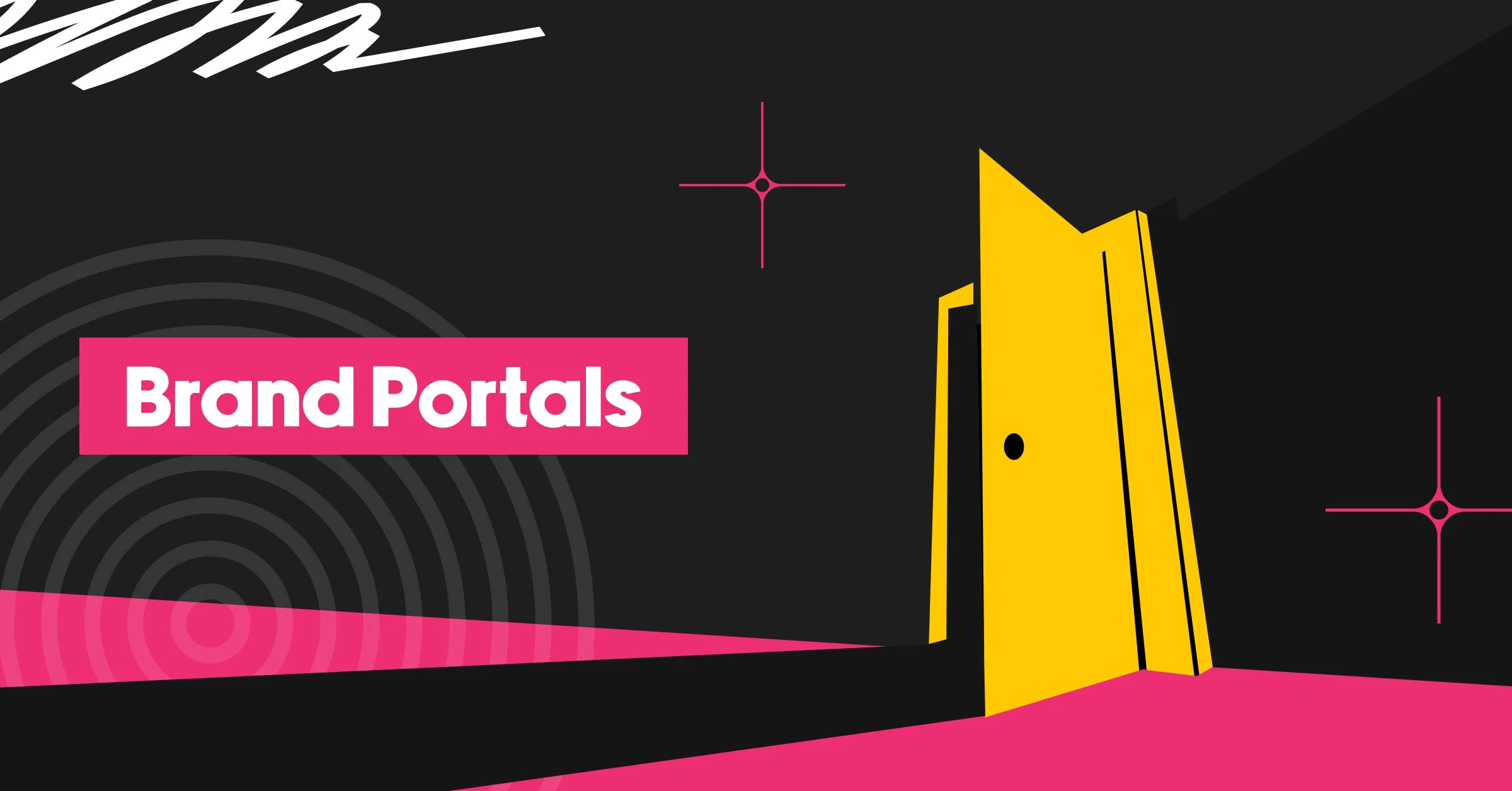If you’re here about brand portals, you’re likely dealing with one of these headaches:
Maybe people are constantly asking you for logos. Maybe your teams are using off-brand or out-of-date assets and decks. Maybe your designers and marketers are buried in busywork, spending too long finding, talking about, and distributing images and collateral for colleagues, prospects, or customers.
This article explains brand portals, how they solve issues like these, and how to use them to scale your brand more effectively.
In this article, you will learn:
- What a brand portal is
- The core features of Marq’s brand portal (powered by our integration partner, MediaValet)
- Seven real-world use cases
- Why a brand portal matters for your business
What Is a Brand Portal?
A brand portal is a centralized, digital hub where your brand’s most important design and messaging assets live. It helps you organize and share branded content with both internal teams and external partners, and avoid relying on scattered folders or internal requests.
Think of a brand portal as an online library that houses everything from logos and fonts to brand guidelines and social media templates, all in one place and accessible to the people who need them.
Most brand portals include the essentials we just mentioned above. But businesses also use them creatively to distribute product launch materials, event collateral, image libraries, sales enablement assets, and more. It’s a scalable way to keep your brand consistent and your teams aligned, no matter how many users and assets are involved.
Nine core features of Marq’s brand portal
It’s easy to mistake a brand portal for a cloud-based storage software or graphic design software. After all, they each give you ways to store and distribute branded content.
But a true brand portal (like the ones available when integrating a brand enablement platform like Marq with MediaValet DAM) offers far more functionality.
With Marq, the brand portal is designed to streamline access, maintain brand control, and scale collaboration across your organization.
Some of the core features include:
- An intuitive page builder: Set up custom brand portals quickly and easily, without technical help.
- Support for multiple file types: Store and share logos, images, fonts, documents, and more.
- Real-time asset updates: Sync directly with your digital asset management (DAM) system so updates are instant and automatic.
- User permissions and role management: Control who can access, edit, or download specific assets.
- Analytics and reporting: Track how often assets are used or downloaded, and by whom, with Marq analytics.
- Templated assets with brand locks: Let users repurpose content while keeping logos, fonts, and colors consistent.
- Multi-channel distribution: Publish assets across different channels directly from the platform.
- Real-time collaboration tools: Work together on designs and approvals without juggling files or feedback.
- Easy sharing: Share portals via custom URLs so anyone from teams, partners, or agencies can find what they need.
Why Brand Portals Matter in Modern Brand Enablement
Brand enablement has become a growing priority for modern marketing teams, and for good reason. With so much of the customer journey happening across digital channels, brand consistency plays a critical role in how your business shows up at every touchpoint.
When your branding looks, feels, and sounds the same across websites, emails, social media, proposals, and presentations, it builds trust and recognition.
In fact, according to the Marq State of Brand Consistency Report, organizations with strong brand consistency see a 33% lift in topline revenue.
There are two main ways that brand portals have a positive impact, which we’ll look at below.
Brand Consistency at Scale
So, why do you even need a brand portal to support brand enablement?
Can’t other tools do the same job?
You might think of tools like Dropbox or Canva as alternatives. But in practice, they’re not as effective for brand enablement at scale. For example, a shared drive doesn’t update automatically when new designs go live; you still have to export and upload each new version manually.
Canva might offer a brand kit, but that doesn’t mean your latest logos, social media templates, or campaign visuals are instantly available for team members. Somebody still needs to export files and find a distribution channel.
A brand portal bridges this gap.
It ensures that marketing teams have a one-stop shop for design, approval, and distribution. Meanwhile, every stakeholder has fast, reliable access to the exact files they need, when they need them, without sacrificing brand control.
Empowerment, Not Bottlenecks
The value of a brand portal goes well beyond scalable distribution. It frees up your marketing and design teams to focus on high-impact work by enabling others to create their own on-brand content.
Marq’s brand portal, for example, combines the flexibility of cloud-based tools with the control of a dedicated brand enablement system. That means anyone with access can find assets, customize locked templates, and share materials without flooding your creative team with constant requests.
The result: fewer delays, more brand consistency, and greater productivity in all departments.
Seven Common Use Cases by Team Size and Industry
See below for some real-world use cases of how Marq templating with digital asset management solutions help marketing teams improve brand consistency at scale.
Brand asset hub
At Marq, we use a brand portal for our own branded assets. The portal includes our visual identity guidelines, logos (in png, svg, colour, black, white, and with or without transparent backgrounds), our fonts, hex codes for brand colours, zoom backgrounds, one-page explainers, case studies, videos for product launches, compliance documents, and more!
Our Brand Asset Hub is both for internal teams and partners, and saves our marketing teams countless hours of lost productivity.
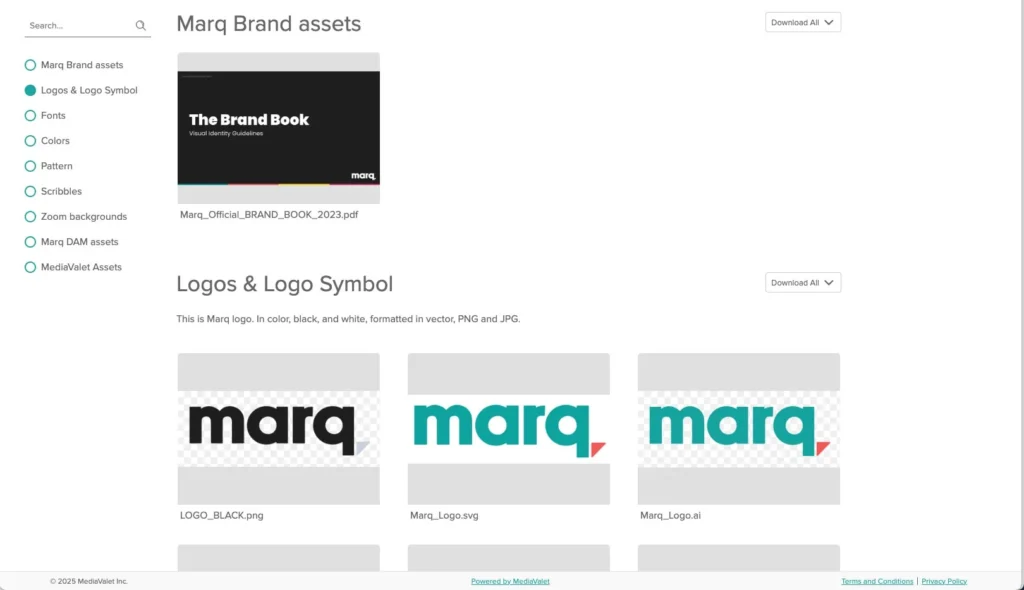
Design approval
Digital Agency, BEAR, uses a brand portal to manage social media campaigns for clients.
When Art Director, Monica, needed to submit the final assets for approval to a client’s marketing team, she created a password-protected brand portal for the client to view the assets for the upcoming campaign.
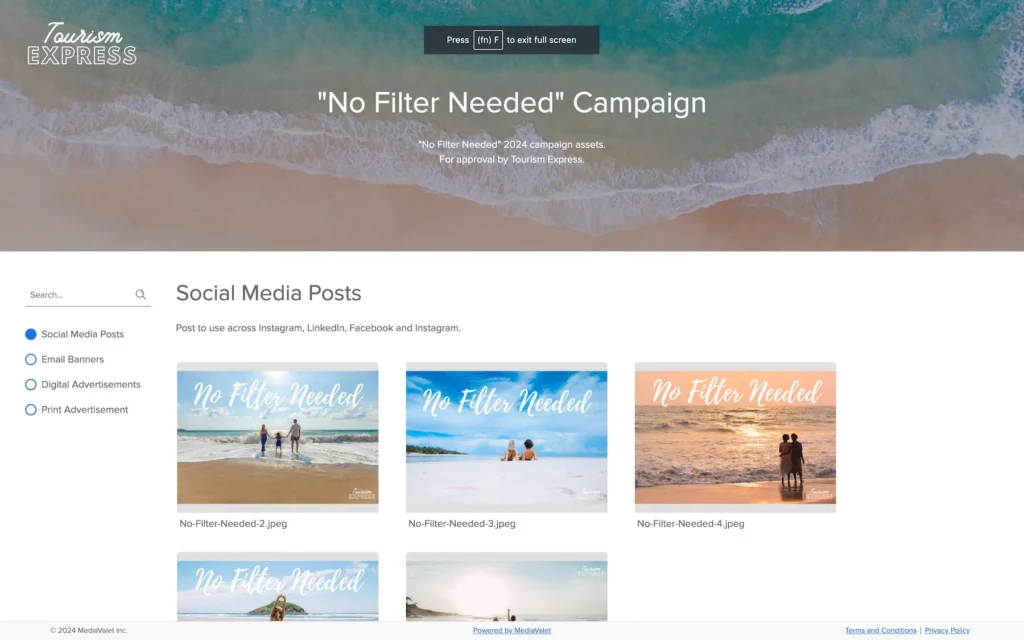
Event branding
During the run up to a recent marketing event, the Marq team used a brand portal to house branding materials, video explainers and background information about us.
This is a popular use case, and we find many clients use a brand portal for one-off events to house brand and partner logos, templated flyers for printing, branded booth backdrops, and more. These assets empower event attendees to prepare for the event without waiting for marketing teams to deliver any assets manually.

Post-event asset sharing
Hill University used a brand portal to host photography from their graduation ceremonies.
The university was able to share a single portal for each graduating class. The relevant degree program name is added to its section, allowing students to locate photos from their graduating class.
Each section is synced with a category inside the digital asset management system (DAM), so if a photographer adds more photos, the portal is updated.
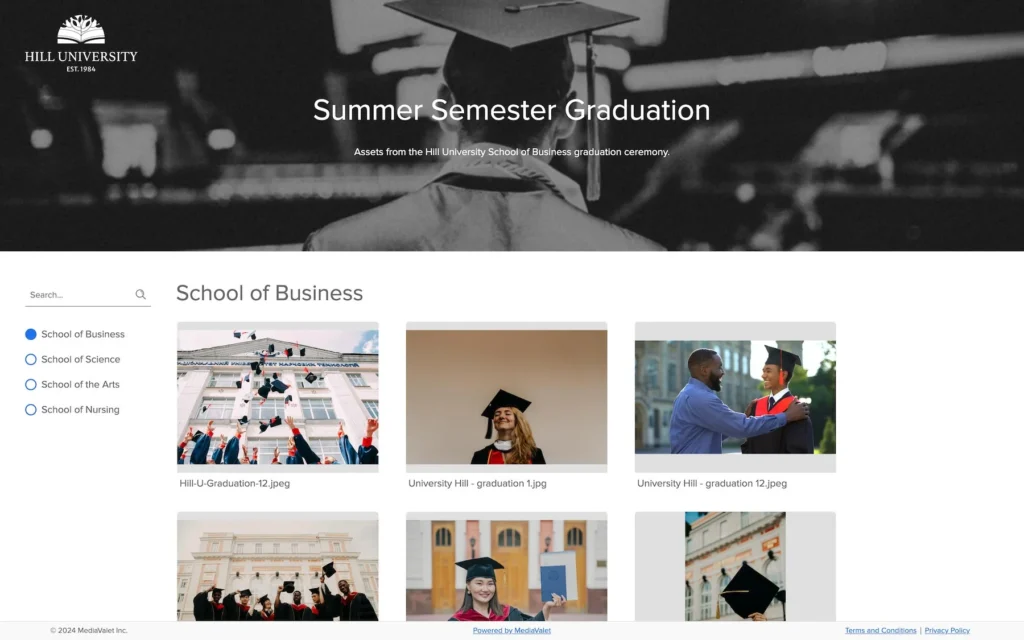
Campaign launch
Leed Lighting, one of North America’s largest lighting manufacturers, used a brand portal to coordinate visual assets during a product launch.
The Leed team wanted to ensure distributors had all the necessary product collateral, such as product images, specification sheets, pamphlets, etc.
Leed’s Marketing Manager created a branded portal and organized it into several sections, so distributors could quickly find and download what they needed.

Self-service marketing portal
Amanda Hodges, Creative Director at The University of Tulsa, joined the Marq team on a webinar to explain how her team used a brand portal to reduce design-related support tickets.
Last year, Amanda opened up a ticketing system for design and marketing requests. Within a few weeks, their team received 2,500 tickets. Most of the tickets were repetitive requests for templated flyers, visual templates to promote events on digital screens, and designs for business cards and stationery.
Amanda’s team used a brand portal with Marq’s templating and MediaValet digital asset management solutions to house writing guides, brand guidelines, logos, flyer templates, digital screen templates, promotional photos, and even a portal for ordering branded stationery.
The self-serve marketing portal reduced the number of tickets while empowering students to create branded solutions by themselves.
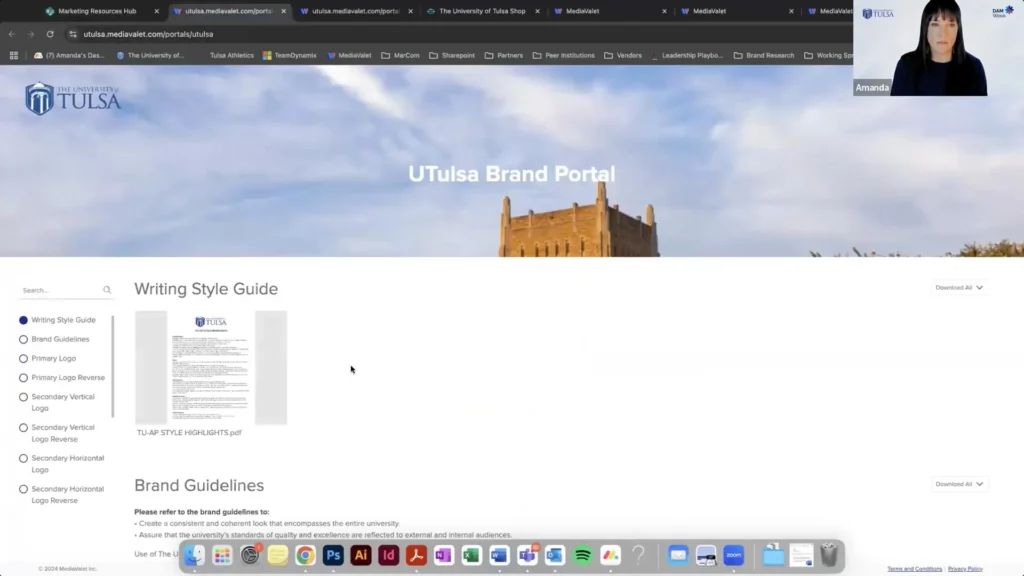
Assets for referral partners/ resellers
Marq also uses a brand portal to manage branded assets for referral partners.
We hear from teams implementing Marq that sales teams constantly ask for logos, branded flyers, case studies, and one-sheet explainers. That’s why our Referral Partner Hub includes assets like a document explaining what Marq is, infographics showcasing our impact, one-sheet explainers about product features, branded case studies, integrations, and value props to help partners talk about Marq in an on-brand way.
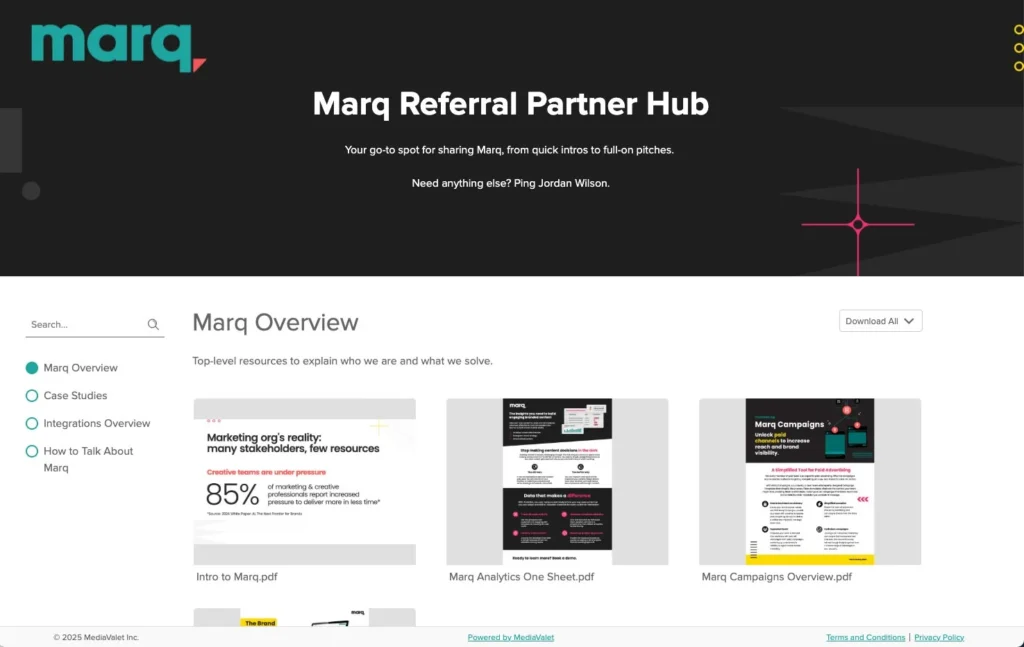
Measuring the ROI of Your Brand Portal
By now, you might be convinced that a brand portal is the right move for your team. But if you’re working within a larger organization, there’s a chance you’ll need stakeholder buy-in to move forward.
So how do you explain the value of a brand portal?
Measuring brand enablement ROI can be tricky. Much of its impact shows up in qualitative ways: less busywork for marketing teams, faster turnaround times for sales enablement content, better asset reuse across campaigns, and fewer off-brand mistakes slipping through the cracks.
Still, several useful metrics can help you track the before-and-after of implementing a brand portal:
- Brand consistency rate: Audit your digital presence and evaluate how often your visual assets follow brand guidelines.
- Content velocity: Measure the time it takes for internal design-related requests to be fulfilled.
- Asset reuse: With Marq’s analytics, you can track how often specific assets or templates are downloaded, and by whom. It’s a tangible way to demonstrate how content is repurposed rather than reinvented.
- Content requests: Compare the number of design and marketing support requests before and after a brand portal implementation.
- Revenue proxy: Many clients tell us that their need to hire additional designers dropped significantly after using Marq’s templating and digital asset management solutions. One even compared the output from their Marq templates to the work of five full-time designers, resulting in operational savings.
Why Marq Makes a Modern Brand Portal Work
A modern brand portal supports brand consistency, empowers teams, and scales your content operations across departments, partners, and regions.
In this article, we’ve looked at what a brand portal is, why it matters for brand enablement, and how to measure its impact. And we’ve shown how the right solution can help you move faster, stay on-brand, and reduce the strain on your marketing and design teams.
Marq is built to do exactly that.
- Content creation is simple with smart templates, drag-and-drop editing, and built-in brand controls.
- Team empowerment comes from flexible user permissions, onboarding support, and easy-to-use tools that let people create without going off-brand.
- Real-time collaboration makes approvals faster and design work smoother.
- Multi-system integration with your DAM, CRM, and other platforms keeps everything in sync.
- Scalable distribution and analytics help you track usage, monitor consistency, and prove ROI as your business grows.
If you’re ready to see how a brand portal can streamline your operations and elevate your brand, schedule a demo to see how Marq can help.
